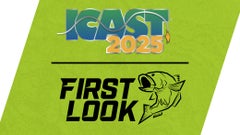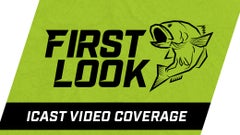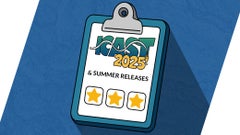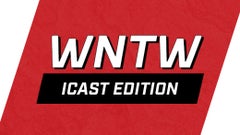JT Kenney Wins FLW Tour Lake Toho
JT Kenney Wins FLW Tour Lake Toho
Kenney was quick to credit fishing buddies Kyle Walters, Jim Folks and Elite Series pro Bobby Lane for allowing him to quiz them on how the Kissimmee Chain might set up this spring. He took that and applied what his hunches were and added that to his on-the-water preparation to formulate a pretty solid game plan. "They're all great friends of mine and they've all put in a lot of time on that place," he said. "They'd tell me, 'I saw this when conditions were like this or that.' I just talked to them and soaked stuff in and combined it with my own experiences. They were all just pieces of the puzzles. I still had to put it all together and still, I almost messed it up." He'd also had the benefit of competing in the Bassmaster Southern Open at Toho in mid-January, but wound up 54th (Lane finished 2nd). By the time the official practice started the Sunday prior to the start of the tournament, he was already fairly certain what type of cover would be holding the better quality fish. "I knew what they were spawning on and with a full moon set for the first day of the tournament in March, it didn't take much to know they'd be moving on to beds," he said. He focused on isolated reeds and lily pads and literally into every bay looking for favorable cover scenarios. He was dialed in, he was picking out individual reeds and pads. "I went and found all the key ingredients on each little clump," he said. "I knew 277 little one-cast spots to check and see if there fish where there, and a darn lot of them had fish on them." He figured 200 of his waypoints had all the facets he was looking for, while others had three components. "I didn't have a wasted cast in 3 days of official practice like I do at other events," he noted. "I was going to specific spots and making casts with a weight, a hitchhiker and a black and blue Gambler Fat Ace. When practice started, I knew exactly where to throw." Knowing the conditions could possibly change or in the event of overcast skies, Kenney also had areas pinpointed where he could get bites with moving baits in Lake Toho. "The place I caught them on a spinnerbait was a place I knew about," he said. "It's a typical fish-holding area with some scattered hydrilla. When it got overcast and windy, I knew I'd need a place where I could go throw a spinnerbait. "I checked that area right before dark one of the days in practice to simulate low-light conditions and caught three or four fish there."
Competition:
Kenney couldn't have scripted a better day to start the tournament and season. The mercury climbed into the 80s - "It was the hottest it's been here since October. I knew it'd be perfect," he said - and his system of color-coding waypoints (yellow meant big fish, red mean big-fish potential) produced nearly 30 pounds in the first 90 minutes of fishing. While others targeted fish that were more bank-oriented or spawning closer to shore, Kenney knew with the water level dropping at a rapid rate, the safer play was to stay out away from the bank. "I wasn't fishing where everybody else was in a foot of water where the water dropped 18 inches in the last couple of weeks," he said. "I don't think big bass if Florida spawn in 18 inches of water anyway." Instead, he was casting the Fat Ace to spots sometimes as small as a cereal bowl where he figured a big fish would be. "I caught some smaller ones, but several times I threw back at the same spot and I'd catch the big one. "When I'd catch one, I'd erase that waypoint because I knew I was not going back there," he added. "I'm sure there were more fish in those areas, but I was fishing for specific fish. It's not like I'd go back and expect to catch another 6-pounder. I sure didn't plan on catching 30 in one spot."
He stuck with his connect-the-dots program on day 2 and came back with 22-09 to open a 12 1/2-pound cushion. He didn't finish off his limit until late in the morning and made several upgrades in the afternoon, as the wind became more of a factor. "What I was fishing around, when it's moving around in the waves, they didn't bite as well," he said. "The wind started out of the north so I went to places that were good for a north wind. Then it switched to the east and I had to adapt. It ended up working out." He played the conditions on Saturday and opted to stay in Lake Toho and try to get a spinnerbait bite going. With the wind blowing out of the northeast again and overcast skies above, he was able to scratch together 14-05 to maintain his 12-pound cushion. "I must've done two laps around the lake that day," he said. "I knew with that cold front, it would mess up the other fish I was fishing for." He had high hopes of being able to return to Lake Kissimmee on the final day to comb areas with waypoints he hadn't hit yet. The only drawback was that he didn't know if those spots had been found by other competitors or if nature had run its course as far as the spawning cycle for those bass. "They were gone," he said. He was still able to scramble around and catch a limit on the Fat Ace, but it was by far his smallest stringer of the week and just big enough to clinch an 11-ounce win over Canterbury.
Winning Gear:
Worm gear: 7'6" heavy-action Halo Fishing Daylite Series casting rod, Pro Qualifier casting reel (7.1:1 ratio), 17-pound Berkley Trilene 100% fluorocarbon line, 3/8-oz. Reins Tungsten slip sinker, 5/0 Lazer TroKar TK130 flipping hook, Gambler Fat Ace (black/blue flake).
Spinnerbait gear: 7'3" Halo Fishing medium-heavy casting rod, Johnny Morris Signature Edition casting reel (6.4:1 ratio), same line, 1/2 Nichols Lures Pulsator spinnerbait (double willow/custom skirt).
Main factor: "Having an understanding on what and how to catch big spawning females in Florida."
Performance edge: "My Power-Poles. You had to place your cast perfectly against those reeds, arrowheads or pads. It had to go right there so without being able to pole down and throw at those specific areas, there's no way I could've won without those Power-Poles."
Bed fishing was a fruitless endeavor since all he could catch were male bass. "I just started fan casting those areas because you couldn't get up on top of the big ones because they'd spooky easily," he said. He did that the first two days and came back with 19-pound bags both days, thanks to 7-pound kickers each day. He switched gears on day 3 and focused more on current-oriented fish. He didn't stick a big fish, but his 14-13 stringer gave him a spot among the 10 finalists. He went back to the soft stick bait on the final and spent some time in Tiger because the conditions were conducive to the area he'd found. On his second flip, he caught a 9-pounder from under a boat dock and rode a 21-10 bag to the runner-up spot. "If it would've hot and sunny all week, there's no telling what the weights would've been," he said. "I had to change every day and I'm really proud of what I did to change with the conditions and fish my instincts." As far as his presentation, "super slow was the whole key," Canterbury said. "If I was throwing it weightless, I had to let it fall to the bottom. Half of the fish bit it while it laying there. Same thing with boat docks, I'd pitch in there and let it sit. "They just wanted it super slow and were not wanting to chase a bait. They were just in that spawning mood."
Worm gear: 7'6 heavy-action Halo Twilite Series casting rod, Ardent Elite Grand casting reel (7.3:1 gear ratio), 15-pound P-Line Ultimate fluorocarbon line, 3/16-, 3/8- and 1/2-oz. unnamed tungsten slip sinkers, 4/0 unnamed offset wide-gap worm hook, Bruiser Baits Stick Worm (black/blue flake). He upsized his weights when casting the worm in areas with current. He also threw the worm weightless at times. Regarding his decision to fish with 15-pound line around some pretty thick cover, he said, "I think that got me more bites. It scares you a little putting 15-pound line under docks and things like that, but I didn't have a problem with it."
Main factor: "The ability to change on the fly and fish the conditions. The other key was fishing super slow this week."
Performance edge: "My Typhoon sunglasses helped me a tremendous amount. The water was lower than it was for the Open and everybody was saying it was heard to see, but those Typhoon glasses were helpful and gave me confidence in what I was looking at. Also, half the fish I caught came with my Power-Poles down to those were a key to slowing down."
Fluke gear: 7'5" medium-heavy Powell Max 3D casting rod, Team Lew's Lite casting reel (7.5:1 ratio), 16-pound unnamed fluorocarbon line, 1/16-oz. Reins Tungsten slip sinker, 4/0 Lazer TroKar offset worm hook, Zoom Super Fluke (watermelon).
Worm gear: 7'6" mag medium-heavy Power Max 3D casting rod, same reel, 20-pound Izor monofilament line, 1/4-oz. Reins Tungsten slip sinker, 4/0 Lazer TroKar offset worm hook, Zoom Trick Worm (junebug).
Lipless crankbait gear: 7'5" heavy-action Powell Max cranking rod, Team Lew's Pro Speed Spool casting reel (6.4:1 ratio), 16-pound unnamed fluorocarbon line, Yo-Zuri Rattl'N Vibe (baby bass).
Main factor: "Being able to adjust and go with my gut and do something different and experiment and explore. Being so far behind, I had to play around and go with my gut."
Performance edge: "My Lowrance electronics were really key for me being able to see those shell beds. And I really think the copper rose lenses in my Typhoon sunglasses really helped me see a lot deeper in the tannic water."
Worm gear: 7' heavy-action Carbon Lite casting rod, Johnny Morris signature series casting reel (6.4:1 ratio), 17- and 20-pound XPS fluorocarbon line, 1/16- and 3/16-oz. tungsten slip sinkers, 3/0 Gamakatsu Finesse Heavy Cover hook, 6" Stick-O (green-pumpkin), Zoom Magnum Speed Worm (junebug).
Main factor: "That face that my wife and I had had several big bites in practice and that zeroed me in what they were doing and it paid off for me."
Performance edge: "My Power-Poles and Lowrance electronics, not so much for the depth but for the course extension features. You can pinpoint a spot 20 miles down the lake and go directly to it."
Worm gear: 7'9" extra-heavy Megabass Orochi XX casting rod, unnamed casting reel, 16-pound Gamma Edge fluorocarbon line, 1/8- and 1/4-oz. unnamed slip sinker, 4/0 unnamed straight shank hook, Z-Man ZinkerZ (black/blue).
Main factor: "Just keeping an open mind and keeping that bait/rod/line setup in my hand. I had confidence in knowing that would work and in finding new areas."
Performance edge: "There's no way I could've caught them that well without my Power-Poles. The way the wind was blowing, you could never get up wind and fish effectively. I put wind at my back, put the poles down and was able to be efficient."




















